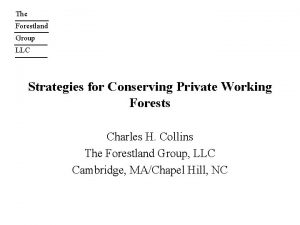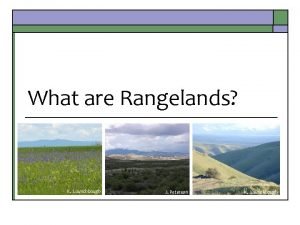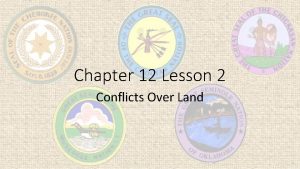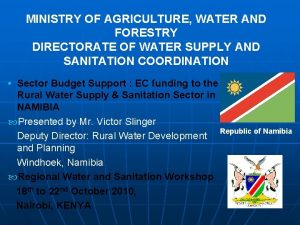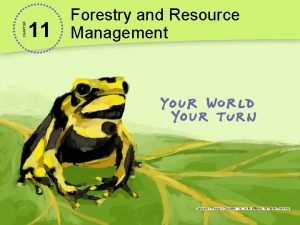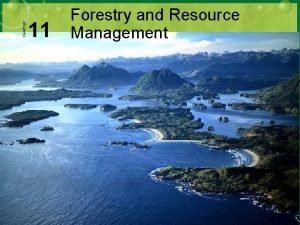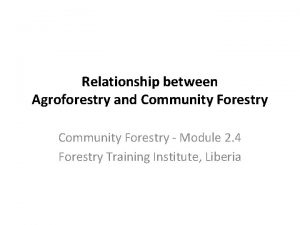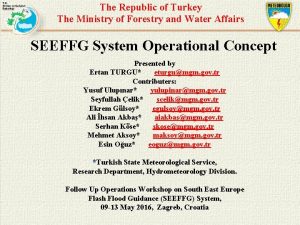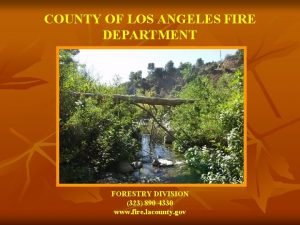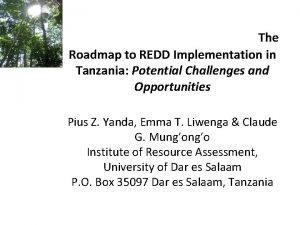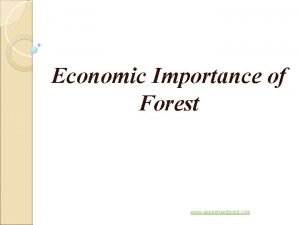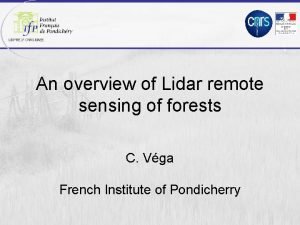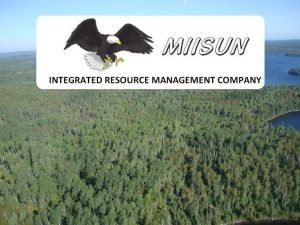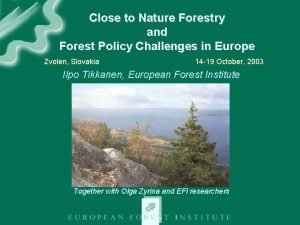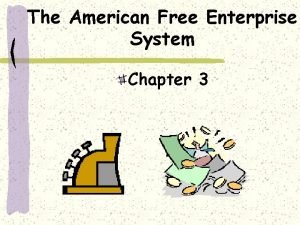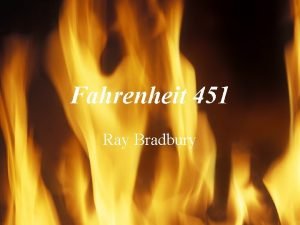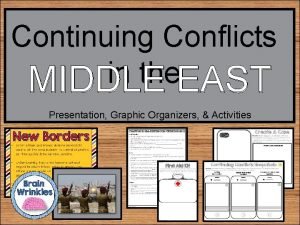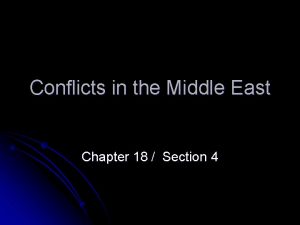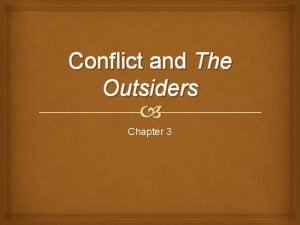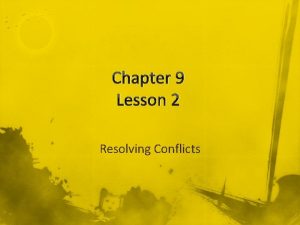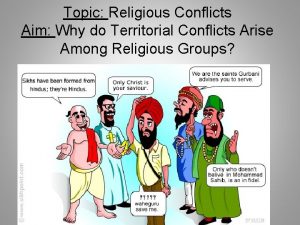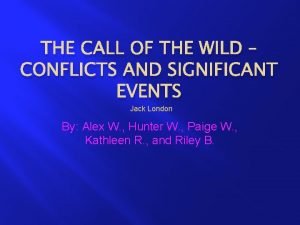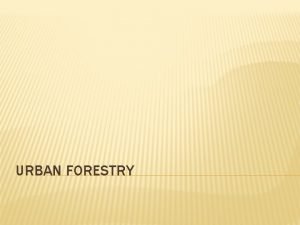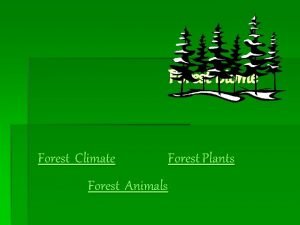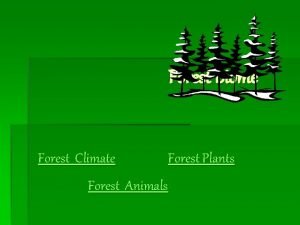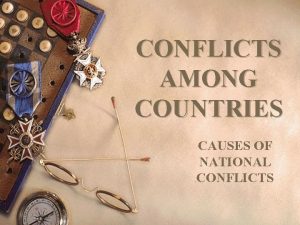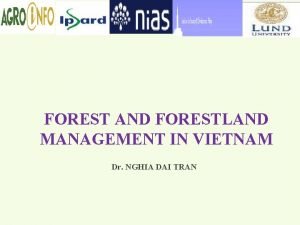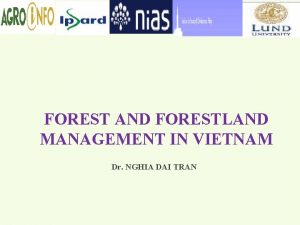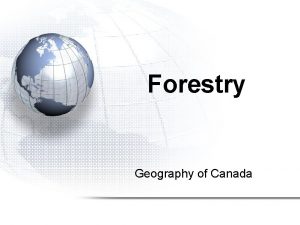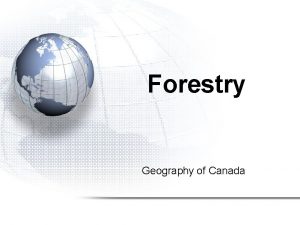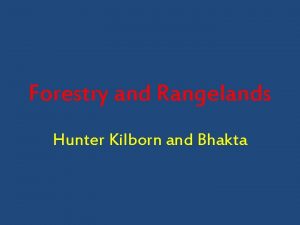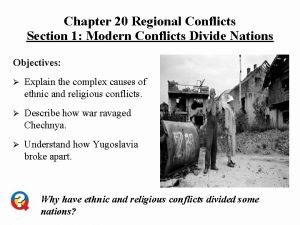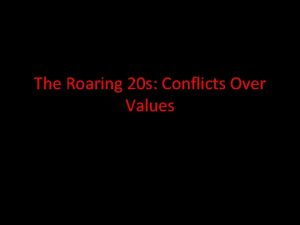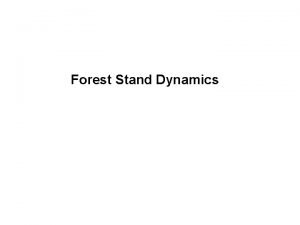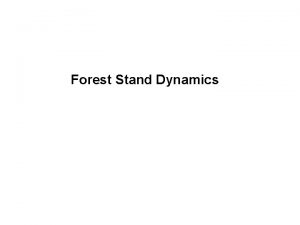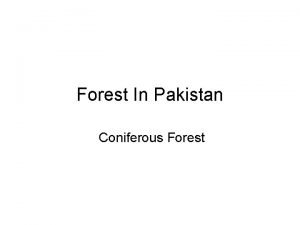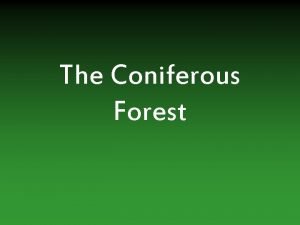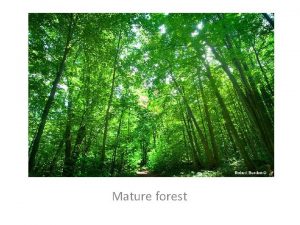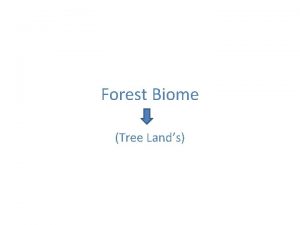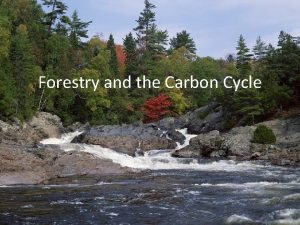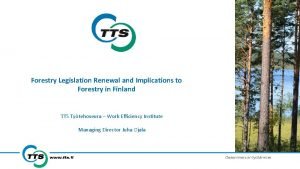Forestry and Rangelands Modern Conflicts over Forestland Forest























































- Slides: 55

Forestry and Rangelands

Modern Conflicts over Forestland Forest Resources • In recent decades forest conservation has become an international cause • What should forest be used for? – Resources vs. conservation


Modern Conflicts over Forestland Forest Resources • Forest and civilization closely linked – Wood major building material and source of fuel • Public service functions – Indirect benefits that people and the environment receive from forests • • Improving watersheds Wildlife habitat Recreation Climate



Tree Niches • Each species of tree has its own niche and adapted to specific environmental conditions – E. g. , water content of the soil – Tolerance of shade – Some adapted to early succession, others to later stages


A Forester’s View of a Forest • Foresters monitor when is the best time to harvest trees in a forest just like on crop land • Traditionally managed in stands – Stand- an informal term foresters use to refer to a group of trees • Usually the same species and successional age • Even- aged stands • Uneven-aged stands • Rotation time- the time between cuts of a stand • Forest that has never been cut is virgin forest – Old growth forest • A forest cut and regrown is secondary growth forest

Approaches to Forest Management • Managing forests can involve – removing poorly formed and unproductive trees to permit larger trees to grow – Planting genetically controlled seedlings – Controlling pests and diseases – Fertilizing the soil

Clear-cutting Technique • Clear-cutting- the cutting of all trees in a stand at the same time and replanting (tress plantation) so that all trees are of the same age. • They get direct sunlight and be harvested at the same time. • Drawbacks – soil erosion, mudslides, decrease nutrients, biodiversity, pattern of water runoff change, causes the soil to lose chemical elements necessary for life


Alternatives to Clear-Cutting • Selective cutting- individual trees are marked and cut (thinning) • Strip-cutting- narrow rows of forest are cut, leaving wooded corridors whose trees provide seeds • Shelter wood-cutting- practice of cutting dead and less desirable trees first and later cutting mature trees. • Seed-tree cutting- removes all but a few seed trees to promote regeneration of the forest




Plantation Forestry • Plantation- a stand of a single species typically planted in straight rows – Much like agriculture – Fertilizers added, mechanized harvesting • Offer a solution to the pressure on natural forests. – High-yield forests could provide all the world’s timber

Sustainable Forestry • A sustainable forest is one from which a resource can be harvested at a rate that does not decrease the ability of the forest ecosystem to continue to provide that same rate of harvest indefinitely.

Land Management may involve both private and public land such as national forests, federal rangelands managed by BLM Land management of forests provide lumber – renewable resource Land management of rangelands through grazing to produce cattle – renewable Both have threats to renewability if not done right. Threats forests include old growth forests, forest fires, tree plantation losing the biodiversity Threats for rangelands include overgrazing, deforestation, desertification

Forests provide • Lumber • Recreation area • Reduce erosion • Carbon sinks (take in a lot of CO 2) • Promote biodiversity Threats - Harvest Old trees- spruce – 90% harvested in north America - Forest Fires- east – more rain – west more fires(prescribed burns, fire suppression lead to more fuel) - Tree Plantations – straight rows- great to harvest lumber but not biodiversity

Rangelands – Tragedy of commons Overgrazing- depleting producers can be avoided by giving Ownership – productive in future Govt. limits/ intervention Deforestation- not much in US – cutting trees- cattle grazing Desertification- once we reach her by combination of overgrazing and deforestation, there is no going back. Taylor Grazing Act- 1934 – permit Bureau of Land Management- Fee too low Protect grazing land but not biodiversity Ostrom’s Law

A Global Perspective on Forests • Vegetation of any kind can affect the atmosphere in four ways – 1. By changing the color of the surface and therefore the amount of sunlight reflected and absorbed. – 2. By increasing the amount of water transpired and evaporated from the surface to the atmosphere.

A Global Perspective on Forests • 3. By changing the rate at which greenhouse gases are released from Earth’s surface into the atmosphere. • 4. By changing “surface roughness”, which affects wind speed at the surface.


World Forest Area, Global Production and Consumption of Forest Resources • Countries differ greatly in their forest resources – Potential of their land climate for tree growth – History of land use and deforestation



World Forest Area, Global Production and Consumption of Forest Resources • Developed countries account foe 70% of world’s total production and consumption of industrial wood products • Developing countries produce and consume about 90% of wood used as firewood • 90% of world timber trade – Construction, pulp and paper – NA is the dominant supplier


World Forest Area, Global Production and Consumption of Forest Resources • In recent years world trade in timber has not grown substantially. • The fundamental questions are – Whether forests can continue to produce at least this amount of timber for an infinite period – Whether they can produce even more as the population grows

Deforestation: A Global Dilemma • Deforestation is estimated to have increased erosion and caused the loss of 562 million hectares of soil. • Deforestation in one country can affects countries downstream – E. g. Nepal and India


Deforestation: A Global Dilemma • Is forested area increasing or decreasing? – Information is lacking on which to base an accurate evaluation – Forest cover is large, often remote – Difficult to assess the total amount of forest area – Estimates suggest an annual loss each year of 7. 3 million hectares

History of Deforestation • Has occurred in all societies from – Early Greece and Roman Empire – Prehistoric farmers in Denmark – Medieval Great Britain – Upon colonization of the New World • The greatest losses in the present century taken place in South America



Causes of Deforestation • Two most common reasons – Clear land for agriculture and settlement – To use to sell timber for lumber, paper products, or fuel

The World Firewood Shortage • In many parts of the world, wood is a major energy source. • As the human population grows, use of firewood increases. – Management is essential

Indirect Deforestation • The death of trees from pollution or disease – Acid rain – Ozone – Other air pollutants – All can increase susceptibility to disease • Global climate change may lead to – Major die-off and shift in areas of potential growth

Parks, Nature Preserves, and Wilderness • Landscapes may be protected in different ways – Government established parks, nature preserves, and wilderness areas – Private organizations buying land maintaining it as nature preserves


Parks and Preserves • Park- an area set aside for use by people • Nature preserve- may be use by people but primary purpose the conservation of some resource • Both create ecological islands – Island biogeography used in design and management

Parks and Preserves as Islands • The size of the park and the diversity of habitats determine the # of species that can be maintained. • The further the park is from other parks or sources of species, the fewer species are found.


Parks and Preserves as Islands • Most park boundaries have been arbitrarily set. • E. g. , Lake Manyara National Park in Tanzania – Original boundaries did not include elephants entire yearly range – Elephants and farmer came into direct conflict – Boundary shifted

Brief History of Parks • The French work parc once referred to an enclosed area for keeping wildlife to be hunted. • E. g. , Coto Donana National Park on the coast of Spain – Once country home of nobles – Now a stop over for 80% of birds migrating between Europe and Africa



Brief History of Parks • First public park – Victoria Park in Great Britain, 1842 • Concept of national park originated in NA in the 19 th century – Yosemite designated in 1864 – Preserve unique awesome landscapes • 20 th century emphasis more ecological

Conflicts in Managing Parks • Major conflicts generally have to do with – Size – What kinds and levels of access and activities will be available

How Much Land Should be in Parks • What percentage of the landscape should be in parks or nature preserves? • If parks are to function as biological preserves, they must be adequate in size and habitat diversity.

Conserving Wilderness • As a modern legal concept, wilderness is an area undisturbed by people. – New idea introduced in the second half of the 20 th century – US Wilderness Act of 1964 • First time wilderness recognized by national law – “land retaining its primeval character and influence”

Conserving Wilderness • Wilderness – 1. Imprint of human work is unnoticeable – 2. There are opportunities for solitude and primitive and unconfined recreation – 3. There at least 5, 000 acres • “Wilderness” vs “Wildness”

Conflicts in Managing Wilderness • Legal definition given rise to several controversies – Desire to include more land as wilderness – Desire to develop this land its natural resources • Can view goal of managing – 1. To preserve nature undisturbed by people – 2. To provide people w/ a wilderness experience

 The forestland group
The forestland group Slidetodoc.com
Slidetodoc.com Brainpop seminole wars
Brainpop seminole wars Ministry of agriculture, water and forestry directorates
Ministry of agriculture, water and forestry directorates Chapter 11 forestry and resource management
Chapter 11 forestry and resource management Chapter 11 forestry and resource management
Chapter 11 forestry and resource management Mendel university of agriculture and forestry
Mendel university of agriculture and forestry State and private forestry
State and private forestry Difference between agroforestry and community forestry
Difference between agroforestry and community forestry Oviposition
Oviposition Eturgu
Eturgu Tending operation includes
Tending operation includes Forestry licence viewer
Forestry licence viewer La county forestry
La county forestry Forestry io roadmap
Forestry io roadmap Careers related to forestry
Careers related to forestry Assignmentpoint.com
Assignmentpoint.com Lidar remote sensing for forestry
Lidar remote sensing for forestry Miisun forestry
Miisun forestry Coop
Coop Forestry tep
Forestry tep State forestry administration
State forestry administration Close-to-nature forestry
Close-to-nature forestry Siach reciting the word over and over
Siach reciting the word over and over Handing over and taking over the watch
Handing over and taking over the watch Over the mountain over the plains
Over the mountain over the plains Chapter 9 resolving conflicts and preventing violence
Chapter 9 resolving conflicts and preventing violence Chapter 9 resolving conflicts and preventing violence
Chapter 9 resolving conflicts and preventing violence The old man and the sea criticism
The old man and the sea criticism Conflict in the crucible
Conflict in the crucible Conflict literature definition
Conflict literature definition Internal conflict in to kill a mockingbird
Internal conflict in to kill a mockingbird Climax of to kill a mockingbird
Climax of to kill a mockingbird Modified free enterprise economy
Modified free enterprise economy Structural conflict
Structural conflict Montag external conflict with society
Montag external conflict with society Conflicts in the middle east comprehension check
Conflicts in the middle east comprehension check Chapter 18 section 4 conflicts in the middle east
Chapter 18 section 4 conflicts in the middle east Conflict frankenstein
Conflict frankenstein The outsiders chapter 3
The outsiders chapter 3 Chapter 9 lesson 2 resolving conflicts
Chapter 9 lesson 2 resolving conflicts Motivational conflict in consumer behavior
Motivational conflict in consumer behavior A horizontal conflict
A horizontal conflict Channel conflicts
Channel conflicts External conflict in animal farm
External conflict in animal farm Conflict literary definition
Conflict literary definition Conflicts in wuthering heights
Conflicts in wuthering heights Character vs supernatural
Character vs supernatural Why do territorial conflicts arise among religious groups
Why do territorial conflicts arise among religious groups Masque of the red death conflict
Masque of the red death conflict Conflicts in call of the wild
Conflicts in call of the wild Falling action in freak the mighty
Falling action in freak the mighty Name two ways to prevent conflicts from building
Name two ways to prevent conflicts from building Stakeholder gcse business
Stakeholder gcse business Conflict in cinderella
Conflict in cinderella Exposition of the lady or the tiger
Exposition of the lady or the tiger
